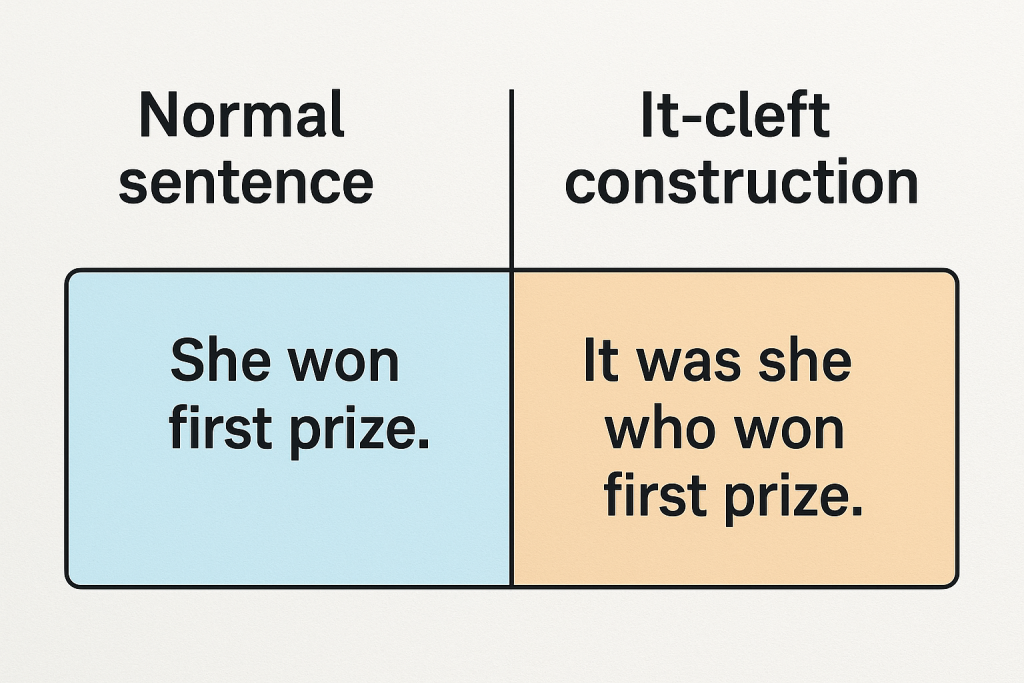Introduction: Emphasis Done Right
Language isn’t just about words—it’s about making the right words stand out. Cleft sentences are like spotlights in your sentence structure: they help you say, “Hey, this is the part I want you to pay attention to.”
If you’ve ever struggled to stress a point without sounding repetitive or awkward, cleft sentences might be exactly what you need. This guide walks you through two powerful variations—it-clefts and what-clefts—with real-life examples, common traps, and practical advice.
Whether you’re an English learner aiming for fluency, a teacher explaining nuance, or a writer polishing prose, this article gives you tools to make your sentences pop. If you’re brushing up on the basics, we also recommend checking out simple subjects and simple sentences.
And if you’re curious how experts define cleft structures, Cambridge Grammar’s explanation on cleft sentences is a solid companion.
What Is a Cleft Sentence?
Let’s start simple: a cleft sentence is your way of saying, “That—right there—is what matters.” You take a standard sentence, split it up, and restructure it to bring one piece into the spotlight.

Why Do We Use Cleft Sentences in English?
Because in English, how you arrange your words changes the rhythm, the tone, and even the message. Cleft sentences help you zero in on what’s important—without sounding repetitive.
Types of Cleft Structures: It-Cleft and What-Cleft
- It-clefts: For highlighting a specific subject, object, time, or place.
- What-clefts: For spotlighting actions or outcomes.
Example Showdown:
- Regular: Sophie made the call.
- It-cleft: It was Sophie who made the call.
- What-cleft: What Sophie did was make the call.
Simple tweaks. Big impact. Want to sharpen your grammar radar even further? Take a peek at verbs ending in -s or reported speech.
It-Cleft Sentences: Structure, Rules & Examples
How They Work:
Structure: It + be (is/was) + focus + relative clause (who/that/which…)
Examples:
- It was my brother who broke the vase.
- It is on Fridays that we meet.
- It was the engine that caused the noise.
When to Use It:
- To stress one element over others
- To clarify “who did what” or “when something happened”
- To sound more persuasive or dramatic
Watch Out For:
- Overcomplicating things in casual speech
- Forgetting to match your verb tense
- Dropping the relative clause—it’s crucial!
Make It Work:
Keep it smooth, not stiff. And if you’re tightening your tone in professional emails, our punctuation guide has your back. Want to rephrase things elegantly? Try our Paraphraser tool.
What-Cleft Sentences: Structure, Rules & Examples

The Blueprint:
Structure: What + subject + verb + be + result
Examples:
- What I admire is your honesty.
- What they found was a solution.
- What we need is clarity.
When It Shines:
- To emphasize what happened, not who did it
- To simplify complex ideas or lead into strong arguments
- In spoken English—natural, clear, and effective
Don’t Do This:
- Turning the “what” clause into a novel
- Combining too many thoughts into one cleft
Pro Tip:
Let the structure breathe. If you’re into sentence rhythm, you might also enjoy our deep dive into modal verbs.
You can also hear how cleft constructions are used in real speech via BBC Learning English’s lesson on emphasis
Using Cleft Sentences in Academic & Professional Writing
You’re not just learning grammar here—you’re learning strategy. Cleft sentences can boost clarity, professionalism, and persuasive power across contexts:
🧠 Academic Writing
- It is the hypothesis that anchors the entire study. Dive deeper into structure with our academic grammar guide.
🗣️ Daily Conversation
- It was you who said we’d leave at 7!
📩 Professional Writing
- What this project reveals is a massive opportunity Check out our email tips if you want to sound crisp and clear.
🎙️ Public Speaking or Storytelling
- It was that one decision that changed everything.
✅ FAQ
Q1: What is a cleft sentence in English grammar?
A cleft sentence is a way of emphasizing part of a sentence by splitting it into two clauses, often starting with It or What.
Q2: What is the difference between It-Cleft and What-Cleft?
It-clefts highlight a subject, object, time, or place (e.g., It was John who called). What-clefts highlight an action or result (e.g., What John did was call).
Q3: Are cleft sentences formal or casual?
It-clefts are common in formal or persuasive writing. What-clefts sound more natural in everyday conversation.
Q4: Can I use cleft sentences in academic writing?
Yes. They help you emphasize key findings or arguments without sounding repetitive.
Q5: What are common mistakes with cleft sentences?
Overusing them, skipping the relative clause, or making them too long. Keep them short and clear.
Final Words: Don’t Just Say It—Emphasize It
English isn’t just about stringing words together—it’s about guiding your reader through your thoughts. Cleft sentences help you point the flashlight at what matters most.
Try them out. Twist, tweak, and tune your sentences with confidence. Want more? Browse our grammar blog or run your writing through our Grammar Checker to clean things up.
Your move: Got a favorite cleft sentence? Questions? Drop a comment or explore more grammar insights—we’ve got a whole library waiting. miss our confused words guide.
